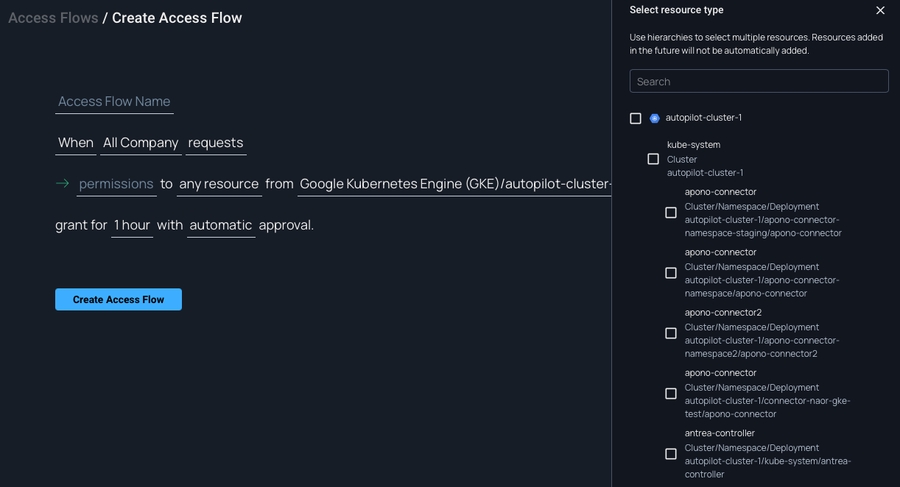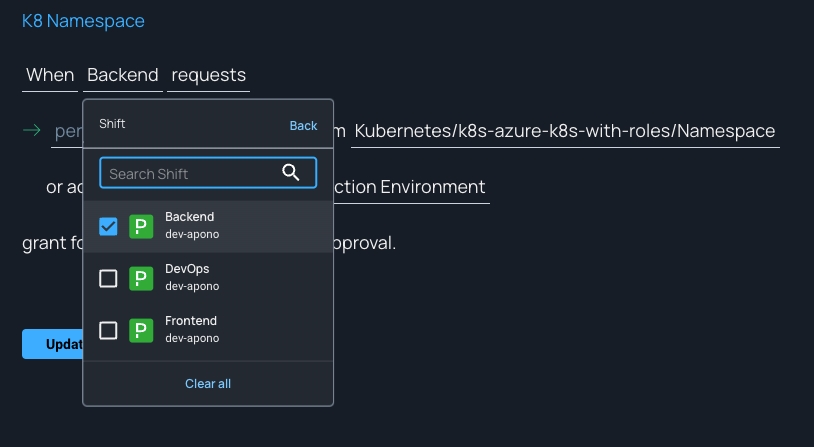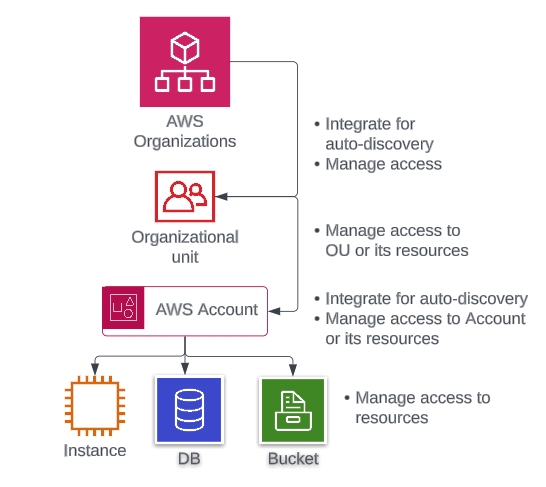
Learn about resource and integration owners
A resource owner is a group or role responsible for a specific resource within a cloud environment, such as AWS, GCP, Azure, or Kubernetes. When you assign a resource owner, this group or role will manage approving or rejecting access to that specific resource.
A resource must also have an integration owner. The integration owner is a fallback individual or group responsible for managing all integration resource access when a resource owner cannot be identified.
Identity Provider Integration
Integration between Apono and an identity provider that enables managing the access of your users and groups
Tags
Key-value pair identifying owners in your cloud environment
Follow these steps to define the resource owner tag:
In your cloud environment, initiate the process for creating a tag.
For the name of the tag, enter a role name, such as owner.
For the value of the tag, enter the name of the group, role, or other identity provider (IdP) attribute. The value must correspond with an identifier within an IdP platform used by your organization and integrated with Apono.
When you update the membership of the group or role in your IdP platform, this change is also reflected in Apono. This approach leverages your existing tag strategy and allows for dynamic, granular control over resource ownership.
This section explains how to set the resource and integration owners for an existing integration. For a new integration, follow the steps in the integration-specific guide.
Follow these steps to define the resource and integration owners for an existing integration:
On the Connected tab of the Integrations page, at the end of the row of an existing integration, click ⋮ > Edit. The Edit Integration page appears.
Under Resource Owner, enter the Key name. This value is the name of the tag created in your cloud environment.
From the Attribute dropdown menu, select an attribute under the IdP platform to which the key name is associated.
Apono will use the value associated with the key (tag) to identify the resource owner.
When you update the membership of the group or role in your IdP platform, this change is also reflected in Apono.
Under Integration Owner, from the Attribute dropdown menu, select User or Group under the under the relevant IdP platform.
This setting is required and is the fallback resource owner if a resource owner cannot be identified.
From the Value dropdown menu, select one or multiple users or groups.
Click Update.
How to turn static access policies into dynamic Access Flows
Access management only really works when automated.
Most companies fall under one of these categories:
Users have permanent access or group membership - this creates stale, unused access and over-privilege, which security and compliance teams, as well as customers, will not accept
Access is managed with tickets and messages, but no one remembers to go and revoke it - this manual process creates overhead for IT or DevOps, doesn't scale and is difficult to track and audit.
Access is automated, but with homegrown solutions, like custom lambda functions, workflow builders, and GitHub repositories - these cool in-house solutions are creative and tailor-made, but require a lot of maintenance (for set-up and whenever the environment or stack changes) and depends on the individuals who built it; if they leave, does anyone know how to operate it?
Which of these applies to your organization?
What can you do?
Turn traditional, static policies into dynamic Access Flows
Automate access revocation with Apono
Use Apono bundles, tags, cloud hierarchies, user attributes, and on-call shifts for dynamic access management
Apono offers out-of-the-box bundles for dynamic access management:
Go to Access Flows
Click the Bundles tab
See all of your existing Bundles - you can edit and delete them
Click Create Bundle; pick Integrations, Resources, and Permissions. Add as many as you want and Save
Go to Access Flows, create a new Access Flow, or edit an existing one: in the resources section, you can switch between Integrations and Bundles by clicking the tab on the top right corner.
Feel free to add other bundles and permissions to resources, set your grantee, access time, approver time, and Save/Update.
Learn about how to use Bundles.
Tags are a great way to dynamically manage your environment; create a tag and apply it to resources like databases, buckets, machines, repositories, and more. With a good tagging strategy you can gain better control of your environments.
Apono supports two types of tags:
Using tags in your cloud environment? Apono syncs tags from AWS, Azure and GCP
Integrate Apono with your cloud environment
Apono will automatically discover and sync tags and their tagged resources
Create a dynamic Access Flow using tags: instead of picking resources by hand, use tags. All resources added to it in the future will be included in the Access Flow and can be requested.
Your organization probably has thousands of resources from different cloud services, tools and data repositories, that may be sensitive for different reasons: some contain financial data, some contain customer data, some may contain PII and others are critical production assets.
You may already be using tagging tools (DSPM) like Varonis, Securiti, Dig Security, Laminar, Centra or others.
With Apono, you can stream these resource tags using our API and dynamically manage access to these resources.
Simply create an Access Flow for some tagged resources, like Prod, Region, PII, etc. and access to all present and future resources tagged will be controlled JIT with Apono based on the access duration and approval flow you set.
Read more here
Apono supports your native cloud hierarchies to allow dynamic management.
Manage access to resources through their parent
Create an Access Flow on a specific resource type
Pick 1 or more parents
Manage access to resources by using exclude
Create an Access Flow on a specific resource type
Pick all resources except specific ones
Any resources except the one(s) selected now or in the future will be included
Manage access to resources by using Any
Create an Access Flow on a specific resource type
Keep the default setting Any
Any resources of this type now or in the future will be included
Apono syncs with your IdP and On-call system to sync user information. As you update users' managers, groups and shifts, Access Flows will automatically change to fit your changes.
Apono integrates with incident response tools like PagerDuty to find who are the developers on duty (also called shifts or on-call).
Want your on-call developers to gain access that will help that troubleshoot and respond to incidents?
Voila! You have dynamic, per-shift Access Flows.
Apono integrates with IdP systems like Okta, Azure AD, JumpCloud, OneLogin and Google Workspace to find who users' report to.
Want your users' managers to approve access requests?
Create an Access Flow where approvers are requesters' managers
All set! You have dynamic, manager-approval Access Flows.
Apono integrates with IdP systems like Okta, Azure AD, JumpCloud, OneLogin and Google Workspace to find groups and their members.
Use this for:
**Dynamic group membership ** If you manage your users access with groups, temporary group membership could be the right solution for you. This is a great way to manage users' access to IAM roles and environments, but not necessarily to granular resources like databases, collections, schemas, buckets, machines, etc.
Create an Access Flow where users can request access to groups
Approval or request controlled by group membership
Create an Access Flow where requesters or approvers are controlled by group membership
Any resources belonging to these parents now or in the future will be included
Create an Access Flow where requesters or approvers are Shift members











